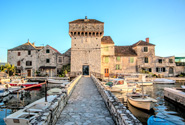
About Kastela
Our town is specific because of the fact that it developed around 7 settlements (Kaštel Štafilić, Kaštel Novi, Kaštel Stari, Kaštel Lukšić, Kaštel Kambelovac, Kaštel Gomilica and Kaštel Sućurac) or around castles. Each village has its own particularity merged into character of this part of Mediterranean...

Beaches
Divulje Beach is located in the westernmost part of Kastela and is situated several hundred meters below the Split airport. The beach is pebbly outside and sandy in the sea. Beach is popular among families with small children and the elderly because of a very gentle sea entrance. There is shower, rent a deck chair and beach bar...
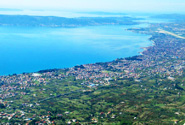
Walking & hiking
Kaštela, owing to its geographic location, can be both a seaside holiday spot and a great mountaineering destination, with a breath-taking view of Kaštela Bay. Kozjak is a mountain located above the town of Kaštela, stretching from Klis in the east to the pass of Malačka in the west...
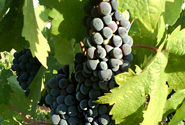
Legend of the wine
Crljenak kaštelanski is an old, almost forgotten, Croatian species of grape which recently captured interest of the wine-making public. The reason for that was discovery that Crljenak kaštelanski and an American species Zinfandel have the same genetic profile. It was established that the two species are the same...
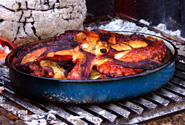
Kaštela – flavours of Dalmatian cuisine
The Dalmatian cuisine is a combination of Mediterranean cooking and the traditional customs of Dalmatian lifestyle. The traditional Dalmatian diet consists of regular intake of cereal, fruit, vegetables, beans and nuts, with plenty of olive oil, fish, red wine and dairy products...
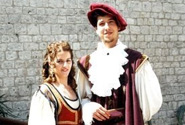
Romeo & Julia from Kaštela
A legend from the second half of the 17th century tells of the tragic love of two young people from Kaštel Lukšić. A daughter, Dobrila, was born to the noble Vitturi family, and a son Miljenko to the Rušinić family. The two later fell in love, but their relationship was forbidden due to hostilities between their families...


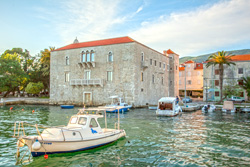 A legend from the second half of the 17th century tells of the tragic love of two young people from Kaštel Lukšić. A daughter, Dobrila, was born to the noble Vitturi family, and a son Miljenko to the Rušinić family. The two later fell in love, but their relationship was forbidden due to hostilities between their families. From the moment their parents learned of their love, Dobrila was under strict supervision, while Miljenko was sent to Venice by his parents. However, this was not the end of it. Dobrila's father arranged that she marry an older noble from Trogir. Miljenko learned about this and arrived at the very moment that the bride and groom were saying their vows, he appeared and stopped the wedding. In order to punish her for the shame that she had brought him, Dobrila's father sent her to a convent in Trogir and, to keep Miljenko from finding her, he ordered Miljenko's death.
A legend from the second half of the 17th century tells of the tragic love of two young people from Kaštel Lukšić. A daughter, Dobrila, was born to the noble Vitturi family, and a son Miljenko to the Rušinić family. The two later fell in love, but their relationship was forbidden due to hostilities between their families. From the moment their parents learned of their love, Dobrila was under strict supervision, while Miljenko was sent to Venice by his parents. However, this was not the end of it. Dobrila's father arranged that she marry an older noble from Trogir. Miljenko learned about this and arrived at the very moment that the bride and groom were saying their vows, he appeared and stopped the wedding. In order to punish her for the shame that she had brought him, Dobrila's father sent her to a convent in Trogir and, to keep Miljenko from finding her, he ordered Miljenko's death. 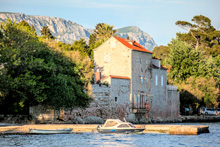 However, Miljenko was clever (disguising himself as a friar) and the plan failed. In attempting to find Dobrila, Miljenko came into conflict with the law and was therefore sentenced to prison in Visovac. There he met a nurse and through her, sent messages to Dobrila and planned his escape. When the two ran off, Dobrila's parents were forced to give in, and they sent a message that the two return to Kaštel Lukšić so that they could be married. After the wedding was held in August 1690, Dobrila's father, unable to come to terms with the fact that his daughter had married Miljenko, killed his new son-in-law on the bridge before the castle. Dobrila lost her mind, fell in and died soon afterwards. Her final wish was to be buried together with Miljenko in the Chapel of St. John in Kaštel Lukšić opposite the castle. The inscription "Peace to the lovers" stands forever on their grave, while both castles, of the Vitturi and Rušinić families, still stand in Kaštel today.
However, Miljenko was clever (disguising himself as a friar) and the plan failed. In attempting to find Dobrila, Miljenko came into conflict with the law and was therefore sentenced to prison in Visovac. There he met a nurse and through her, sent messages to Dobrila and planned his escape. When the two ran off, Dobrila's parents were forced to give in, and they sent a message that the two return to Kaštel Lukšić so that they could be married. After the wedding was held in August 1690, Dobrila's father, unable to come to terms with the fact that his daughter had married Miljenko, killed his new son-in-law on the bridge before the castle. Dobrila lost her mind, fell in and died soon afterwards. Her final wish was to be buried together with Miljenko in the Chapel of St. John in Kaštel Lukšić opposite the castle. The inscription "Peace to the lovers" stands forever on their grave, while both castles, of the Vitturi and Rušinić families, still stand in Kaštel today. 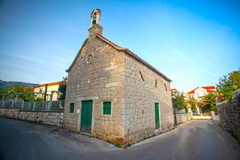 The fate of the two young lovers has inspired: novels, an opera and a theatre play, while the children's home in Kaštel Lukšić, situated near their final resting site, bears the name Miljenko and Dobrila.
The fate of the two young lovers has inspired: novels, an opera and a theatre play, while the children's home in Kaštel Lukšić, situated near their final resting site, bears the name Miljenko and Dobrila.